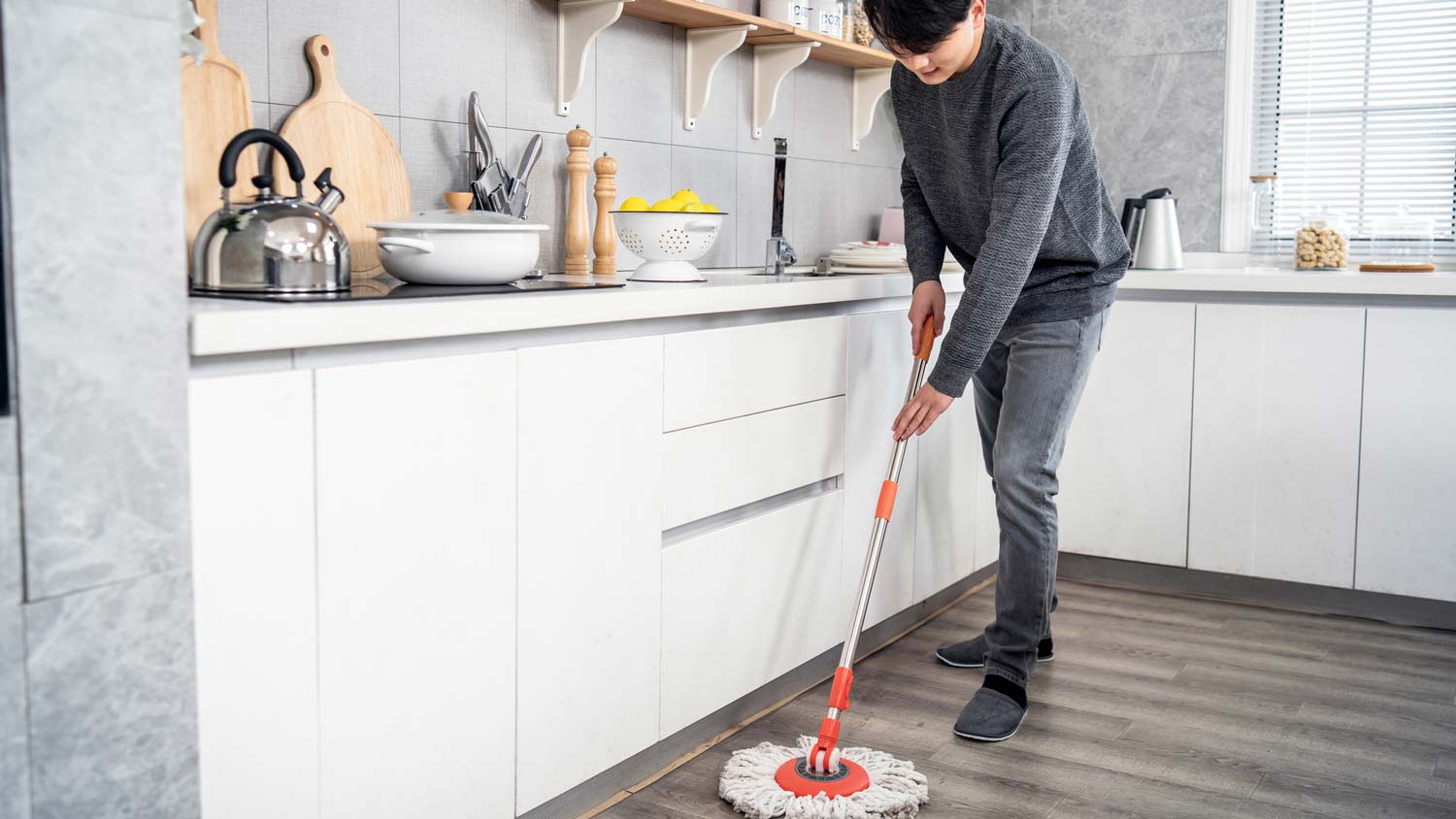
Clean walls are an important part of a well-kept house. Use this wall cleaning cost guide to see what it would cost to hire a professional to get the job done.
No need to get into hot water the next time you have a messy spill


Cold water is best for delicate fabrics, sticky substances, and pet urine.
Hot water is best for coffee, wine, and ink stains.
Avoid water altogether for oil-based stains and fabrics with dry clean only instructions.
From a glass of red wine dropped on your favorite rug to muddy paw prints on the couch, stains are an unfortunate part of daily life. To keep spills and smudges from becoming permanent, it’s essential to work quickly, but you also need to know when to use hot or cold water for stains. Hot water is best for removing gum, for example, but it can cause a mustard stain to set. If your first attempt at removing a stain from your rug, sofa, or other household item isn’t successful, it may be time to call in a local professional cleaning service who will have the right tools and solutions to handle the job.
A variety of cleaning agents exist in detergents and stain removers to help break down grease and dirt, and they can work in different ways. Some work better in hot water and some in cold. Some solvents even work best if you treat the stain with cold water but then wash the item thoroughly in hot water afterward. In any case, make sure you follow the directions on the label as well as the cleaning instructions for the stained fabric.
The best chance to get the stain out completely is to address it quickly before it sets. That’s because set-in smudges and grime are harder to get out, no matter which temperature of water you use. Here's a quick cheat sheet for determining when to use hot or cold water for stains.
| Stain Type | Hot or Cold Water? |
|---|---|
| Grass | Cold |
| Pigmented Food | Cold |
| Juice | Cold |
| Milk | Cold |
| Sticky Substances | Cold |
| Urine | Cold |
| Water-Based Paint | Cold |
| Egg | Cold |
| Water-Based Ink | Hot |
| Chocolate | Hot |
| Coffee | Hot |
| Wine | Hot |
| Gum | Hot |
| Dyes | Hot |
| Lotion | Hot |
| Sweat | Hot |
The enzymes in most detergents work better in hot water, but there are instances when cold water will do the trick. Cold water is also ideal for spot-treating stains when you're trying to keep the substance from sinking further into the fabric.
Some over-the-counter or DIY stain removers can make stains worse. If you are unsure of the material and the stain is over a week old, a professional cleaner will know the correct solution to use.
Stains on delicate fabrics like wool, satin, and silk should only be removed using cold water. Keep this in mind when cleaning curtains, bed linens, and area rugs, which are more likely to be made from these delicate fabrics. If they can handle water at all—some may be dry clean only—always stick with cold water to avoid damaging the fibers.
Whether they’re new or set-in, grass stains respond best to cold water. If possible, keep the stained fabric moistened with cold water to avoid setting even further. Soaking the fabric in cold water will help soften the stain, making it easier for detergents or spot cleaning solutions to do their job.
Cold water works best on highly pigmented foods, such as cheese, jelly and jam, soy sauce, baby food, and mustard. Hot water might actually set natural or added food dyes. If you get to the food immediately, the cold water should rinse out the stain pretty quickly.
If there are young kids in the house, you’ve probably had at least one bottle or sippy cup leak all over the couch. Tackle spilled juice and milk with cold water and your choice of DIY upholstery cleaning tips. Pat (don’t rub) the stain with cold water, or let it soak in cold water before washing the material in cold water and detergent.
It’s best to remove glue, toothpaste, blood, and deodorant with cold water. The same goes for the residue left by stickers on your kid’s shirts or the living room rug. Never use hot water on sticky stuff because you could bake in the stain rather than remove it altogether.
Fight water with cold water—it may take a couple of washes, but any stain left by water-based paint or urine should ultimately rinse out. Did the urine or paint end up on your furniture? Go the extra mile to remove the smell from the couch as well. If the upholstery can handle a steam cleaner, switch to heat after the stain is gone to ensure there are no lingering odors.
Dried stains from egg protein can be challenging to get out of clothing and tablecloths alike. Your best bet is soaking a shirt, pants, rugs, or other washable fabrics in cold water before washing. Never use hot water, or you’ll have baked eggs.

If you have a stain on something white, or if an item has untreated stains from weeks ago, hot water is the way to go. Never use dry heat to remove stains. But, before you use hot water, make sure the garment can withstand high heat, or you might end up with a shrunken version of your best sweater.
Ink can be challenging to remove from clothing, upholstery, or linens. Dabbing the stain with too much water or rubbing it vigorously could make it spread further. Hot water is best, but warm water will also work. You’ll also need detergent or a spot treatment and rubbing alcohol to get the job done, as well as a microfiber cloth to blot out as much ink as possible.
Everyone loves chocolate—until it becomes a brown stain on your sofa cushion or your best kitchen towels. If you catch the stain quickly, you may get it out simply by running the fabric under cold water or blotting the chocolatey mess with a cloth soaked in cold water. But if the stain has set, hot water is best. The same rules apply for coffee stains.
Whether it’s carpet or clothes, red wine has the potential to ruin most fabrics. Avoid rubbing the stain, as this can push it deeper into the fibers. If your stain is on a tablecloth or a pair of white pants, stretch the fabric until it’s taut, then carefully pour boiling water over the stain. You can also wash the garment in the washing machine and only place it in the dryer if the stain is completely gone. Lastly, if the party ends and you find that the red wine has set into the carpet, use a combination of baking soda and warm water to remove a stubborn stain from the rug.
Gum isn’t only nasty on the bottom of your shoes. It can also be hard to get out of furniture and clothing. For clothing, you can stick the garment in the freezer and try to scrape the gum off once it’s frozen, but that can leave a residue. Running the fabric under hot water (or, for floor coverings and furniture, treating the spot with hot water) might be a better way to separate the gum from the material.
If your white underwear is now pink thanks to a red towel, add one cup of white vinegar to the hot water cycle in your washing machine. Vinegar is typically harmless to most fabrics, but you might test a small area just to be sure. You can also use an oxygen-based bleach (follow label directions) and detergent.
Remove runaway lotion using hot water. It's best to apply a few drops of stain remover or laundry detergent directly to the problem area and scrub it out. Then wash the item in the hottest recommended setting.
Did the kids come in from soccer practice and hop right on the couch? Sweat stains and smells require warm water, and even steam cleaning, to break up the oils and bacteria-fueled odors. Since sweat stains often cover a large area, check your fabric cleaning instructions to see if it can handle a hot run in the washer or a pass with the steam cleaner.
In some cases, water will only exacerbate stains instead of breaking them up. Water can also damage delicate fabrics that are dry clean only.
Oil and water don’t mix. So, using hot or cold water on their own likely won’t remove an oily stain from clothing or household items. That being said, there are plenty of DIY cleaners that can break down oil-based stains when combined with water. Depending on the stain and fabric, combine warm water with a gentle soap solution, white vinegar, or baking soda to counteract the basic nature of the oil. Similarly, remove oil stains from your driveway with absorbent materials such as sawdust or a solvent that will balance out the oil, such as white vinegar.
Use the same technique to remove rust stains from clothing and other home fabrics as you would to treat an oil stain. Your best bet to remove rust stains is to dab the area with a mixture of baking soda or cornstarch and water. Work in a bit of dish soap and wash as usual. If the stain is persistent, repeat.
Some area rugs and carpets can't handle water-based cleaning solutions. If you have a major stain on either, be sure to investigate the material of the fibers or check out the attached cleaning tag. Determine whether steam cleaning or dry cleaning is the best bet for the fibers, and keep in mind that the cost of calling in a professional may be worth it for severe stains.
No matter which substance spills on upholstery, always check the care label before treating a stain with water. If the label reads code-S, only dry cleaning solvents can be used on the material. Calling a professional upholstery cleaner is best in this case.
If you’ve found mystery stains on clothing or other materials, you may be wondering whether you should try washing the stain in hot or cold water. You don’t want to risk setting the stain further, so it may be a good idea to try cold water first. However, hot water does seem to work better on many stains. Just check labels, and for machine washable items, never throw anything in the dryer until the stain is gone.
Kathryn Pomroy contributed to this piece.
From average costs to expert advice, get all the answers you need to get your job done.

Clean walls are an important part of a well-kept house. Use this wall cleaning cost guide to see what it would cost to hire a professional to get the job done.

How often should you deep clean your house? Learn what timing factors to consider before deep cleaning your home.

Construction leaves dust and debris in its wake. If you hire a pro to handle it, here are the post-construction cleanup questions you should be ready to answer.

Flat paint is great for hiding imperfections but presents issues with cleaning. Learn how to clean walls with flat paint the right way in this simple DIY guide.

Life is messy, but when it comes to pee in the house, it takes on a whole new meaning. Read this to learn how to get urine smells out of your couch.

Keep on top of the mess in one of the busiest rooms in your home with our daily, weekly, monthly, and seasonal living room cleaning checklists.